Garcia-Zamor Intellectual Property Law, LLC
The Complete IP Portfolio
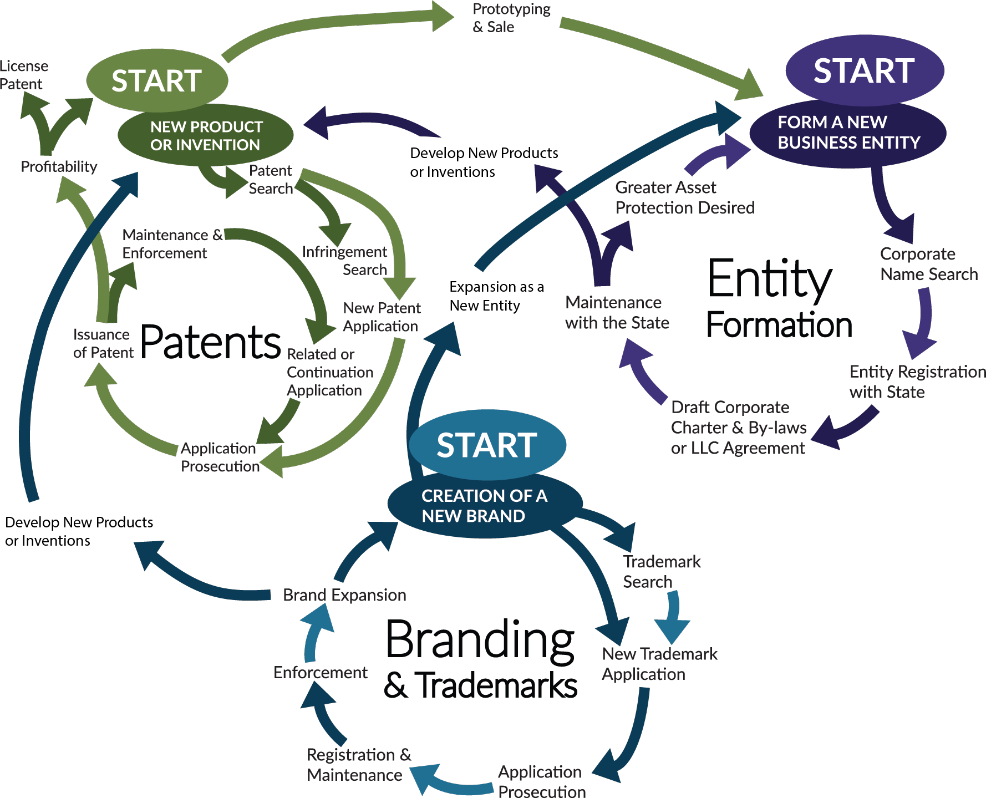
Patents
We work closely with our clients to develop comprehensive patent strategies. The best patent protection may not come from a single patent, but from a portfolio of multiple related patents, international patents, and the proactive enforcement of patent rights.
We offer a wide range of patent services to help clients of all sizes as they develop products and build their businesses.
- Patent Searches & Patentability Opinions
- Patent Searches & Clearance Opinions
- Patent Audits & Patent Mapping
- Patent Studies & Infringement Opinions
- Patent Searches & Clearance Opinions
- Provisional Patent Applications
- Design Patent Applications
- Utility Patent Applications
- Licensing, Ndas, Negotiations & Other Documents
- Enforcement & Defense Actions
Patent Searches & Patentability Opinions
This service is the best way to determine the likelihood of whether patent protection is available for your invention.
These patentability searches are conducted at the US Patent and Trademark Office among issued patents and published patent applications. Our searches are conducted by professional searchers with whom we have worked for many years. While we have many years of hands on search experience, it is our belief that the use of professional searchers is more cost effective.
This process starts with you providing us with detailed explanations of your invention. Then, we explain the invention to the searcher who will then provide us with patent references related to your invention. After we carefully study the identified patent references, we prepare a written opinion as to the patentability of your invention.
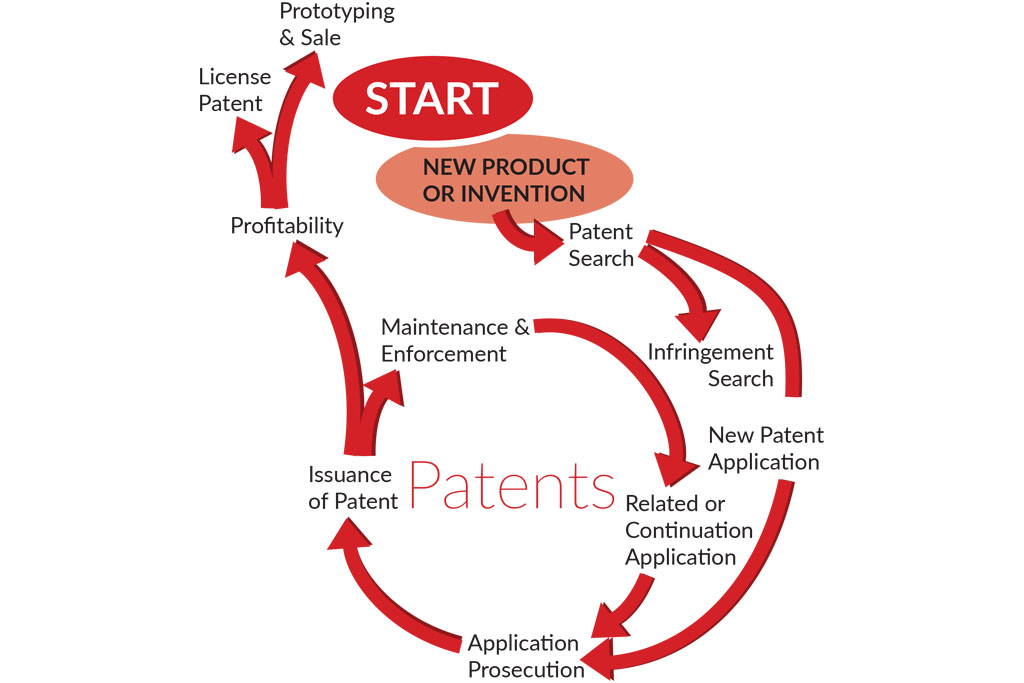
Patent Searches & Clearance Opinions
This service is the best way to study a broad number of patents and determine whether it is likely that manufacturing or selling your product may infringe someone else’s patent.
This services should be used when you wish to determine not only whether an invention may be patentable, but whether it’s manufacture or sale could pose an infringement risk. Furthermore, these opinions can be used by you to modify the manufacture of your invention so as to reduce potential infringement liability.
These infringement searches are conducted at the US Patent and Trademark Office among issued patents and published patent applications. An infringement search is much more comprehensive than a patentability search because it must be a broader search. The reason for this is that it is possible to be patentable over a patent and still infringe the patent.
Our written clearance (right to make) opinions include the following. For each of the valid patents we review each independent claim and identify those elements which are not present in the invention so that you can have maximum information regarding potential infringement. When examining the independent claims we consider both literal infringement and infringement by the doctrine of equivalents.
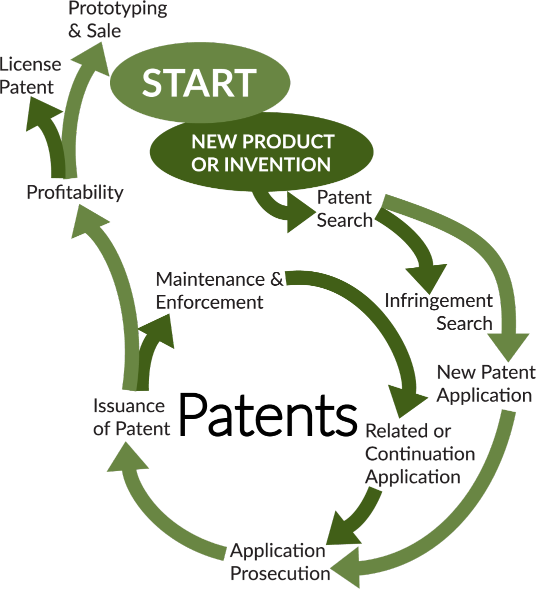
Patent Audits & Patent Mapping
Patent audits are valuable for those with large patent portfolios to ensure that proper maintenance fees are paid and that title is properly recorded. Patent mapping is the best way to determine what the competition is doing and to find areas in which research should be directed to maximize the return on research expenditures.
A patent map is a graphical model used to visualize interrelationships between patents. This makes it easier for you to identify those patents in a particular technology area and to identify correlations between different patent groups.
A patent audit involves systematically studying patents owned, used or purchased by your business. These audits are directed to quantifying any challenges to your company’s financial health, identifying under-utilized patent assets, and to enable your businesses to create tailored plans to enhance its competitive position.

Patent Studies & Infringement Opinions
This involves a comprehensive analysis of a single patent, including all correspondence to and from the USPTO, to determine whether your product is likely to infringe that patent.
An infringement opinion is typically requested when you are already aware of a particular patent that may pose a serious infringement risk. Alternatively, a competitor may already have made an allegation against you in connection with such a patent.
These opinions are directed to a single patent of interest and involve obtaining a complete copy of the patent file history, studying the file history, and preparing a detailed infringement opinion letter. This type of written opinion regarding noninfringement can be relied on in court as a defense against a willful infringement charge (a written clearance opinion cannot be relied on in court).

Patent Searches & Clearance Opinions
Provisional patents are an important tool in establishing the earliest date of invention when development, time, or financial constraints make deferring the preparation of a non-provisional utility application advisable.
Provisional patents may allow you to record a patent application with the U.S. Patent and Trademark Office in the shortest period of time. This is important because the US is a ‘first to file’ patent system. If a third party files a patent application for an invention prior to your filing of an application then the third-party is entitled to obtain patent rights even if you developed the invention before they filed their application. For this reason, it is important for you to file a patent application as soon as possible if patent rights are desired.
A provisional patent application can never turn into a US patent but is a placeholder for establishing a date of invention for your potential patent rights. To obtain an enforceable US utility patent you must initially file a non-provisional patent application or you must file a non-provisional patent application within twelve months of your earlier filed provisional patent application.

Provisional Patent Applications
Provisional patents are an important tool in establishing the earliest date of invention when development, time, or financial constraints make deferring the preparation of a non-provisional utility application advisable.
Provisional patents may allow you to record a patent application with the U.S. Patent and Trademark Office in the shortest period of time. This is important because the US is a ‘first to file’ patent system. If a third party files a patent application for an invention prior to your filing of an application then the third-party is entitled to obtain patent rights even if you developed the invention before they filed their application. For this reason, it is important for you to file a patent application as soon as possible if patent rights are desired.
A provisional patent application can never turn into a US patent but is a placeholder for establishing a date of invention for your potential patent rights. To obtain an enforceable US utility patent you must initially file a non-provisional patent application or you must file a non-provisional patent application within twelve months of your earlier filed provisional patent application.

Design Patent Applications
Design patents are a critical tool for protecting the look of your invention which can be used in a complementary fashion with utility applications.
A design patent application seeks to protect a novel aesthetic appearance (“design”) in an article. The purpose of the application drawings is to illustrate the design for which protection is desired. Absolute identity between design patent drawings and a competitor’s product is not necessarily required for infringement.
You may benefit from using design patent applications to supplement utility patent applications for your inventive products. While utility patent applications are directed to how your products work, specific functionality in the products, or how your new products are constructed; design patent applications are directed to how your products look. Supplementing utility patent applications with design patent applications can be beneficial for multiple reasons: (1) an infringer may copy a look of a popular product without incorporating the patented technology therein, (2) design patents issue much faster than utility patents so you are provided with at least some remedy against knock offs while waiting for your utility patent applications to issue, and (3) design patent applications have a different legal test for infringement which can provide you with additional legal options against infringers.

Utility Patent Applications
To protect the core of your idea, how your invention is made, or the structure of your invention, non-provisional utility applications are used as the intellectual property mechanism.
Obtaining patent protection can provide you with exclusive rights to make, use, and sell your invention. For that reason, it is important to meet with the attorneys of Garcia-Zamor prior to disclosing your new developments to the public or to third parties. That way you stay in control of your idea until a decision is made as to whether seeking patent protection makes sense.
Securing patents can provide a huge competitive advantage over the competition while making it more costly for others to compete with you. Patents also make it easier to secure greater market share while providing time for consumers to associate your inventions with your branding.

Licensing, Ndas, Negotiations & Other Documents
Properly crafted documents and agreements can minimize disputes, avoid the loss of intellectual property rights, and minimize the cost of any future litigation.
Carefully crafted licenses and settlement agreements allow your patents to be monetized and generate valuable revenue streams.
Nondisclosure agreements (NDAs) are used to prevent your meetings with potential vendors, manufacturers, distributors, or designers from necessarily being considered public disclosures. US patent applications need to be filed within one year of any public disclosure. “Public disclosure” includes a prior sale, offer for sale, prior use, prior publication, prior public and general knowledge, or similar public displays or advertising. After the one-year period is complete, US patent filings are barred by law.
Contracts with employees and vendors can play a critical role in providing additional enforcement mechanisms to protect trade secrets and prevent loss of valuable business information. Software development licenses and end-user licenses have a critical role to play in protecting your software solutions and in regulating authorized uses of your software solutions.

Enforcement & Defense Actions
If everything starts to go wrong, we are there to guide and represent you at every step of the process, from cease-and-desist letters to litigation.
Patents can be used offensively to allow you to regulate who uses your creations, technologies or designs. This will allow your company to charge more than competing products that do not include your innovations. Patents can also be used defensively. Having patents for a specific technology can deter competitors from accusing you of infringement of their patents on similar technology.
Regardless of your circumstances, the attorneys of Garcia-Zamor have the experience to help you devise a litigation strategy within your budget. Our focus is on providing you with a resolution that makes good business sense so that you can continue to succeed in the marketplace.

Patent Searches & Patentability Opinions
Patent Searches & Patentability Opinions
This service is the best way to determine the likelihood of whether patent protection is available for your invention.
These patentability searches are conducted at the US Patent and Trademark Office among issued patents and published patent applications. Our searches are conducted by professional searchers with whom we have worked for many years. While we have many years of hands on search experience, it is our belief that the use of professional searchers is more cost effective.
This process starts with you providing us with detailed explanations of your invention. Then, we explain the invention to the searcher who will then provide us with patent references related to your invention. After we carefully study the identified patent references, we prepare a written opinion as to the patentability of your invention.

Patent Searches & Clearance Opinions
Patent Searches & Clearance Opinions
This service is the best way to study a broad number of patents and determine whether it is likely that manufacturing or selling your product may infringe someone else’s patent.
This services should be used when you wish to determine not only whether an invention may be patentable, but whether it’s manufacture or sale could pose an infringement risk. Furthermore, these opinions can be used by you to modify the manufacture of your invention so as to reduce potential infringement liability.
These infringement searches are conducted at the US Patent and Trademark Office among issued patents and published patent applications. An infringement search is much more comprehensive than a patentability search because it must be a broader search. The reason for this is that it is possible to be patentable over a patent and still infringe the patent.
Our written clearance (right to make) opinions include the following. For each of the valid patents we review each independent claim and identify those elements which are not present in the invention so that you can have maximum information regarding potential infringement. When examining the independent claims we consider both literal infringement and infringement by the doctrine of equivalents.

Patent Audits & Patent Mapping
Patent Audits & Patent Mapping
Patent audits are valuable for those with large patent portfolios to ensure that proper maintenance fees are paid and that title is properly recorded. Patent mapping is the best way to determine what the competition is doing and to find areas in which research should be directed to maximize the return on research expenditures.
A patent map is a graphical model used to visualize interrelationships between patents. This makes it easier for you to identify those patents in a particular technology area and to identify correlations between different patent groups.
A patent audit involves systematically studying patents owned, used or purchased by your business. These audits are directed to quantifying any challenges to your company’s financial health, identifying under-utilized patent assets, and to enable your businesses to create tailored plans to enhance its competitive position.

Patent Studies & Infringement Opinions
Patent Studies & Infringement Opinions
This involves a comprehensive analysis of a single patent, including all correspondence to and from the USPTO, to determine whether your product is likely to infringe that patent.
An infringement opinion is typically requested when you are already aware of a particular patent that may pose a serious infringement risk. Alternatively, a competitor may already have made an allegation against you in connection with such a patent.
These opinions are directed to a single patent of interest and involve obtaining a complete copy of the patent file history, studying the file history, and preparing a detailed infringement opinion letter. This type of written opinion regarding noninfringement can be relied on in court as a defense against a willful infringement charge (a written clearance opinion cannot be relied on in court).

Patent Searches & Clearance Opinions
Patent Searches & Clearance Opinions
Provisional patents are an important tool in establishing the earliest date of invention when development, time, or financial constraints make deferring the preparation of a non-provisional utility application advisable.
Provisional patents may allow you to record a patent application with the U.S. Patent and Trademark Office in the shortest period of time. This is important because the US is a ‘first to file’ patent system. If a third party files a patent application for an invention prior to your filing of an application then the third-party is entitled to obtain patent rights even if you developed the invention before they filed their application. For this reason, it is important for you to file a patent application as soon as possible if patent rights are desired.
A provisional patent application can never turn into a US patent but is a placeholder for establishing a date of invention for your potential patent rights. To obtain an enforceable US utility patent you must initially file a non-provisional patent application or you must file a non-provisional patent application within twelve months of your earlier filed provisional patent application.

Provisional Patent Applications
Provisional Patent Applications
Provisional patents are an important tool in establishing the earliest date of invention when development, time, or financial constraints make deferring the preparation of a non-provisional utility application advisable.
Provisional patents may allow you to record a patent application with the U.S. Patent and Trademark Office in the shortest period of time. This is important because the US is a ‘first to file’ patent system. If a third party files a patent application for an invention prior to your filing of an application then the third-party is entitled to obtain patent rights even if you developed the invention before they filed their application. For this reason, it is important for you to file a patent application as soon as possible if patent rights are desired.
A provisional patent application can never turn into a US patent but is a placeholder for establishing a date of invention for your potential patent rights. To obtain an enforceable US utility patent you must initially file a non-provisional patent application or you must file a non-provisional patent application within twelve months of your earlier filed provisional patent application.

Design Patent Applications
Design Patent Applications
Design patents are a critical tool for protecting the look of your invention which can be used in a complementary fashion with utility applications.
A design patent application seeks to protect a novel aesthetic appearance (“design”) in an article. The purpose of the application drawings is to illustrate the design for which protection is desired. Absolute identity between design patent drawings and a competitor’s product is not necessarily required for infringement.
You may benefit from using design patent applications to supplement utility patent applications for your inventive products. While utility patent applications are directed to how your products work, specific functionality in the products, or how your new products are constructed; design patent applications are directed to how your products look. Supplementing utility patent applications with design patent applications can be beneficial for multiple reasons: (1) an infringer may copy a look of a popular product without incorporating the patented technology therein, (2) design patents issue much faster than utility patents so you are provided with at least some remedy against knock offs while waiting for your utility patent applications to issue, and (3) design patent applications have a different legal test for infringement which can provide you with additional legal options against infringers.

Utility Patent Applications
Utility Patent Applications
To protect the core of your idea, how your invention is made, or the structure of your invention, non-provisional utility applications are used as the intellectual property mechanism.
Obtaining patent protection can provide you with exclusive rights to make, use, and sell your invention. For that reason, it is important to meet with the attorneys of Garcia-Zamor prior to disclosing your new developments to the public or to third parties. That way you stay in control of your idea until a decision is made as to whether seeking patent protection makes sense.
Securing patents can provide a huge competitive advantage over the competition while making it more costly for others to compete with you. Patents also make it easier to secure greater market share while providing time for consumers to associate your inventions with your branding.

Licensing, Ndas, Negotiations & Other Documents
Licensing, Ndas, Negotiations & Other Documents
Properly crafted documents and agreements can minimize disputes, avoid the loss of intellectual property rights, and minimize the cost of any future litigation.
Carefully crafted licenses and settlement agreements allow your patents to be monetized and generate valuable revenue streams.
Nondisclosure agreements (NDAs) are used to prevent your meetings with potential vendors, manufacturers, distributors, or designers from necessarily being considered public disclosures. US patent applications need to be filed within one year of any public disclosure. “Public disclosure” includes a prior sale, offer for sale, prior use, prior publication, prior public and general knowledge, or similar public displays or advertising. After the one-year period is complete, US patent filings are barred by law.
Contracts with employees and vendors can play a critical role in providing additional enforcement mechanisms to protect trade secrets and prevent loss of valuable business information. Software development licenses and end-user licenses have a critical role to play in protecting your software solutions and in regulating authorized uses of your software solutions.

Enforcement & Defense Actions
Enforcement & Defense Actions
If everything starts to go wrong, we are there to guide and represent you at every step of the process, from cease-and-desist letters to litigation.
Patents can be used offensively to allow you to regulate who uses your creations, technologies or designs. This will allow your company to charge more than competing products that do not include your innovations. Patents can also be used defensively. Having patents for a specific technology can deter competitors from accusing you of infringement of their patents on similar technology.
Regardless of your circumstances, the attorneys of Garcia-Zamor have the experience to help you devise a litigation strategy within your budget. Our focus is on providing you with a resolution that makes good business sense so that you can continue to succeed in the marketplace.

Trademarks
Registered trademarks are one of the most affordable and effective ways to protect a business’s reputation. This makes a registered trademark a musthave asset for all businesses. More comprehensive protection can be obtained using co-branding and multilevel branding strategies.
We offer a wide range of trademark services including:
- Trademark Searches & Opinions
- Federal Trademark Applications
- Intent-To-Use Federal Trademark Applications
- Brand Evaluation & Branding Strategies
- Assignments, Licenses & Other Legal Agreements
- Monitoring The Market & Enforcement
Trademark Searches & Opinions
The best way to determine the likelihood of trademarkability or trademark infringement is with a comprehensive search of federal, state, and proprietary databases, as well as other publications.
In addition to selecting potential trademarks that fit a particular business marketing strategy, it can be critical to determine whether a mark is likely to be registered or to create potential legal liabilities prior to your use or even filing the initial trademark application.
Risks associated with not preparing a trademark search and opinion prior to use of the trademark or filing trademark applications include, but are not limited to: having to change advertising; having to pull product from distributors and store shelves; having to change your product name; having to explain to current or prospective customers the reason for the change; losing the time, money, and expense involved with selecting the trademark and filing a trademark application; and legal fees and possible damages resulting from an accusation of infringement.
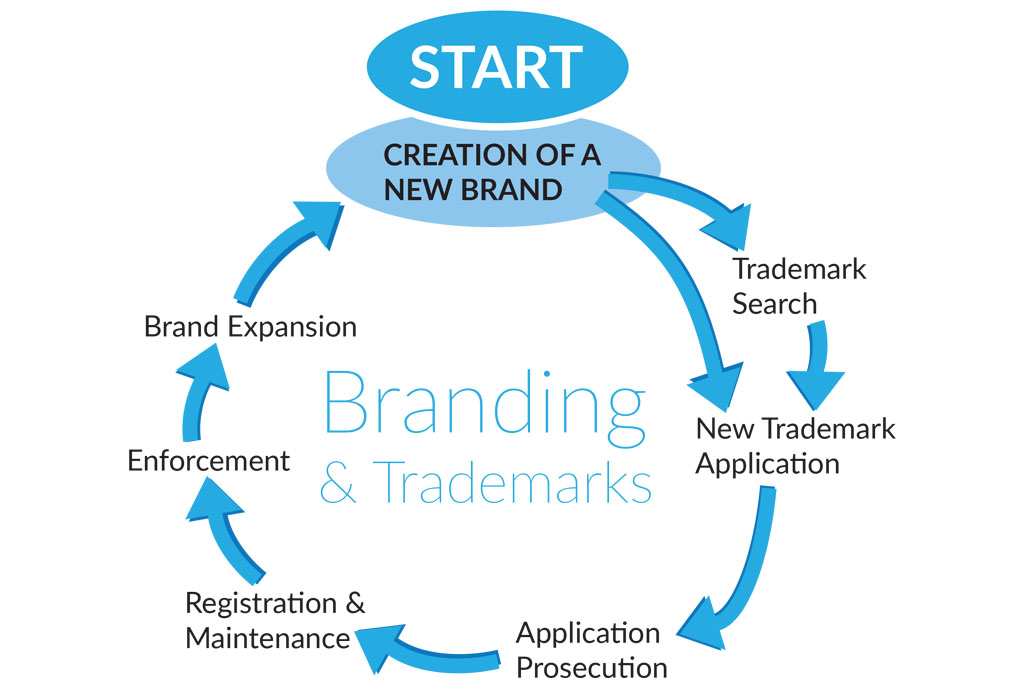
Federal Trademark Applications
Preparing a new trademark application and communicating with the USPTO throughout the application process can ensure that the broadest possible protection is obtained.
Trademarks often play a vital role in branding and marketing strategies for your company as they allow consumers to easily identify you as the source of goods offered for sale. Federal trademark registrations allow you to secure your branding which in the long run may be your most valuable asset. A carefully crafted portfolio of trademark registrations that secure your brands can significantly increase your payback on marketing investments and facilitate growth. Additionally, trademark registrations can increase the value of your company when selling the company, taking on partners, or applying for financing.
Securing your branding with federal trademark registrations is also critical when you expect to franchise your business down the road. What franchisees are really paying you for is the ability to use your brands to take advantage of the goodwill and recognizability associated with the brands

Intent-To-Use Federal Trademark Applications
In some cases, it may be advisable to file a trademark application prior to the introduction of a new brand to secure potential rights at the earliest possible date.
This type of trademark application can be filed in advance of use as long as you have a bone fide intent to use the mark in commerce in the United States of America. Then after a notice of allowance is received and the statement of use is filed, the registered trademark rights will be effective as of the filing date of the application. This is true even though your use of the mark may not occur until years after the application is filed.
When there is a trademark dispute one of the most important issues is which party has superior rights. That is, whose rights in the mark vested earlier. Filing an intent to use application rather than waiting for actual use allows you to secure an earlier date of vested trademark rights which can be very valuable.

Brand Evaluation & Branding Strategies
Existing brands can be better protected through the adoption of new brands or the creation of sub-brands.
A comprehensive branding strategy often includes more than just obtaining a federal trademark registration for your company’s name or for one of its products. It can include trademarking the company name, a slogan, product names, and ancillary products.
Regular review of your existing trademark/branding assets is important in maximizing protection. Over time, the way one of your brands is presented/displayed or the goods and services with which it is used may change. When this happens it may be advisable that you file additional trademark applications.

Assignments, Licenses & Other Legal Agreements
Properly crafted agreements can minimize disputes, avoid the loss of intellectual property rights, and minimize the costs of any future litigation.
Any transfer or assignment of a registered or unregistered trademark must include underlying goodwill. Section 10(a)(1) of the Lanham Act, 15 U.S.C. Section 1060(a), requires that any assignment of a registered mark or a mark for which an application to register has been filed “shall be assignable with the goodwill of the business in which the mark is used, or with that part of the goodwill of the business connected with the use of and symbolized by the mark.”
All trademark licenses must include quality control provisions that ensure that you are monitoring how the trademarks are used and verifying the quality of the goods and services. Failure to include such controls can result in a court ruling that the registered trademark is abandoned and has no force.

Monitoring The Market & Enforcement
We work to assist our clients in proactively enforcing their trademark rights to ensure their brands are protected.
To maximize the benefit, protection, and commercial value of a registered trademark, it is important to regularly check whether anybody else is using confusingly similar trademarks without permission. When determining the current strength of a registered trademark (“mark”) one important factor to consider is the presence of unauthorized, confusingly similar trademarks by others. Unauthorized use of a confusing similar trademark can reduce or eliminate the rights of a mark. Accordingly, to maintain the value in any mark, it is important that you take action to eliminate any unauthorized confusingly similar trademarks that are detected.

Trademark Searches & Opinions
Trademark Searches & Opinions
The best way to determine the likelihood of trademarkability or trademark infringement is with a comprehensive search of federal, state, and proprietary databases, as well as other publications.
In addition to selecting potential trademarks that fit a particular business marketing strategy, it can be critical to determine whether a mark is likely to be registered or to create potential legal liabilities prior to your use or even filing the initial trademark application.
Risks associated with not preparing a trademark search and opinion prior to use of the trademark or filing trademark applications include, but are not limited to: having to change advertising; having to pull product from distributors and store shelves; having to change your product name; having to explain to current or prospective customers the reason for the change; losing the time, money, and expense involved with selecting the trademark and filing a trademark application; and legal fees and possible damages resulting from an accusation of infringement.

Federal Trademark Applications
Federal Trademark Applications
Preparing a new trademark application and communicating with the USPTO throughout the application process can ensure that the broadest possible protection is obtained.
Trademarks often play a vital role in branding and marketing strategies for your company as they allow consumers to easily identify you as the source of goods offered for sale. Federal trademark registrations allow you to secure your branding which in the long run may be your most valuable asset. A carefully crafted portfolio of trademark registrations that secure your brands can significantly increase your payback on marketing investments and facilitate growth. Additionally, trademark registrations can increase the value of your company when selling the company, taking on partners, or applying for financing.
Securing your branding with federal trademark registrations is also critical when you expect to franchise your business down the road. What franchisees are really paying you for is the ability to use your brands to take advantage of the goodwill and recognizability associated with the brands

Intent-To-Use Federal Trademark Applications
Intent-To-Use Federal Trademark Applications
In some cases, it may be advisable to file a trademark application prior to the introduction of a new brand to secure potential rights at the earliest possible date.
This type of trademark application can be filed in advance of use as long as you have a bone fide intent to use the mark in commerce in the United States of America. Then after a notice of allowance is received and the statement of use is filed, the registered trademark rights will be effective as of the filing date of the application. This is true even though your use of the mark may not occur until years after the application is filed.
When there is a trademark dispute one of the most important issues is which party has superior rights. That is, whose rights in the mark vested earlier. Filing an intent to use application rather than waiting for actual use allows you to secure an earlier date of vested trademark rights which can be very valuable.

Brand Evaluation & Branding Strategies
Brand Evaluation & Branding Strategies
Existing brands can be better protected through the adoption of new brands or the creation of sub-brands.
A comprehensive branding strategy often includes more than just obtaining a federal trademark registration for your company’s name or for one of its products. It can include trademarking the company name, a slogan, product names, and ancillary products.
Regular review of your existing trademark/branding assets is important in maximizing protection. Over time, the way one of your brands is presented/displayed or the goods and services with which it is used may change. When this happens it may be advisable that you file additional trademark applications.

Assignments, Licenses & Other Legal Agreements
Assignments, Licenses & Other Legal Agreements
Properly crafted agreements can minimize disputes, avoid the loss of intellectual property rights, and minimize the costs of any future litigation.
Any transfer or assignment of a registered or unregistered trademark must include underlying goodwill. Section 10(a)(1) of the Lanham Act, 15 U.S.C. Section 1060(a), requires that any assignment of a registered mark or a mark for which an application to register has been filed “shall be assignable with the goodwill of the business in which the mark is used, or with that part of the goodwill of the business connected with the use of and symbolized by the mark.”
All trademark licenses must include quality control provisions that ensure that you are monitoring how the trademarks are used and verifying the quality of the goods and services. Failure to include such controls can result in a court ruling that the registered trademark is abandoned and has no force.

Monitoring The Market & Enforcement
Monitoring The Market & Enforcement
We work to assist our clients in proactively enforcing their trademark rights to ensure their brands are protected.
To maximize the benefit, protection, and commercial value of a registered trademark, it is important to regularly check whether anybody else is using confusingly similar trademarks without permission. When determining the current strength of a registered trademark (“mark”) one important factor to consider is the presence of unauthorized, confusingly similar trademarks by others. Unauthorized use of a confusing similar trademark can reduce or eliminate the rights of a mark. Accordingly, to maintain the value in any mark, it is important that you take action to eliminate any unauthorized confusingly similar trademarks that are detected.

Business Legal Services
Properly formed business entities are critical for business success. These mechanisms allow you to separate business and personal assets and facilitate the resolution of many business disputes that might otherwise end in litigation. Working with us to establish your business entity and prepare related legal documents can guarantee that everything is coordinated with the rest of your intellectual property portfolio. This maximizes your legal protections in an efficient manner.
We encourage all of our clients to consider the following services:
- Business Entity Formation
- Registered Agent Services
- Name Availability Searches
- Operating Agreements & Bylaws
Business Entity Formation
Drafting articles of incorporation or organization and other legal documents, in accordance with state law, separates your assets from potential liabilities.
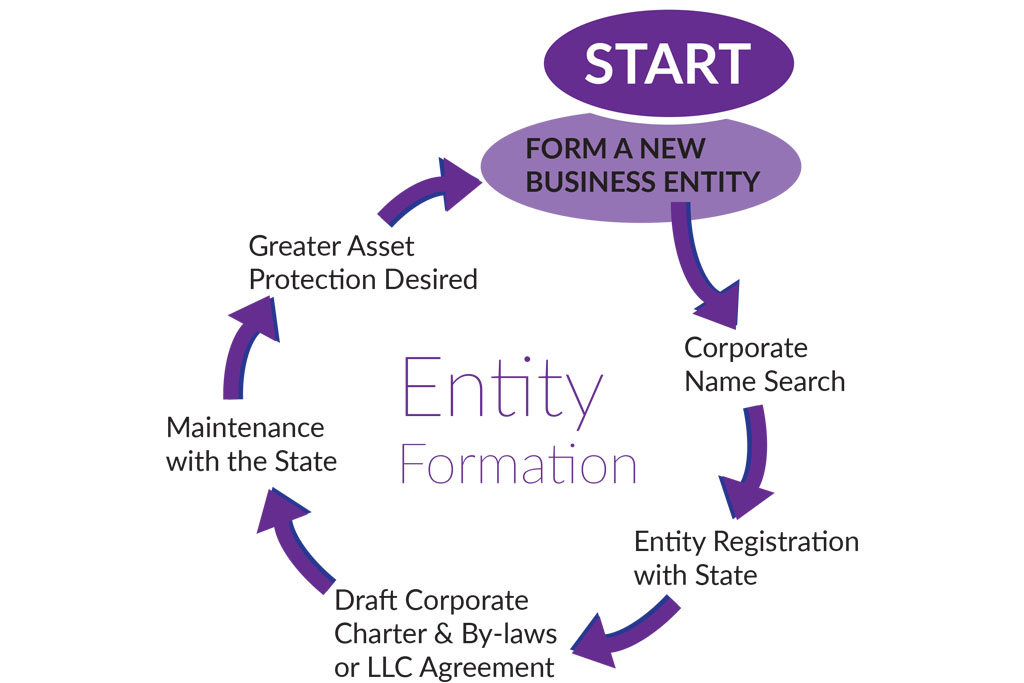
Registered Agent Services
We monitor and remind you of necessary annual filings, and receive and forward service of process.

Name Availability Searches
The best way to select a strong trade name is to determine the availability of the desired name by searching the USPTO trademark database, all 50 state trademark offices, journal databases, social media, corporate name registries, and more.

Operating Agreements & Bylaws
We draft custom operating agreements and bylaws based upon careful consideration of your business needs, goals, and outlook to help you focus on building your business.

Business Entity Formation
Business Entity Formation
Drafting articles of incorporation or organization and other legal documents, in accordance with state law, separates your assets from potential liabilities.

Registered Agent Services
Registered Agent Services
We monitor and remind you of necessary annual filings, and receive and forward service of process.

Name Availability Searches
Name Availability Searches
The best way to select a strong trade name is to determine the availability of the desired name by searching the USPTO trademark database, all 50 state trademark offices, journal databases, social media, corporate name registries, and more.

Operating Agreements & Bylaws
Operating Agreements & Bylaws
We draft custom operating agreements and bylaws based upon careful consideration of your business needs, goals, and outlook to help you focus on building your business.

Why Garcia-Zamor?
A complete intellectual property portfolio is like a set of golf clubs. Patents are like your irons, trademarks your woods, and other legal documents like your specialty clubs. You may be able to play a round with one or two clubs, but that would be a tremendous competitive disadvantage, especially when you’re up against players with a full set of clubs.

Experience
Garcia-Zamor has over two decades of experience helping a wide range of clients, from individuals to multimillion dollar corporations, develop complete intellectual property portfolios.

Reputation
Garcia-Zamor is trusted by companies of all sizes, including some of the largest corporations in the US and law firms in numerous other countries. This reputation is the result of consistently delivering high quality work.

Quality Services
Garcia-Zamor delivers the highest quality work product at affordable prices to help our clients maximize their intellectual property budgets.

Teamwork
Our collaborative approach guarantees that multiple attorneys will review every matter, ensuring that all strategies are considered and every matter is given our full attention.
The Best Choice
Garcia-Zamor is the best choice for helping you develop your complete intellectual property portfolio.
Our goal is to offer advice and services to help you build a complete intellectual property portfolio. You may be starting with a single invention, idea, or brand, but these starting points can be gateways to numerous intellectual property protections. No business or invention can reach its full potential without making the best use of patents, trademarks, proper business entity formation, licensing agreements, employee agreements, NDAs, and more.
Build Your Complete IP Law Portfolio
Garcia-Zamor Intellectual Property Law, LLC has years of experience in IP Law helping individuals and multimillion dollar corporations develop intellectual property portfolios. Contact an IP lawyer on our team today to protect your intellectual property and corporate branding.
- Patent Searches & Opinions
- Patent Prosecution
- Trademark And Copyright Matters
- Licensing And Transactions
- Litigation And Enforcement
- Intellectual Property Audits
- Beverage Laws And Regulations
- Business Legal Services

Patent Searches and Opinions
Garcia-Zamor provides patent searches and opinions. We can conduct an in-depth search of all existing patent collections to determine what aspects of your new idea may be patentable.

Patent Protection
Preparing a non-provisional patent application and interfacing with the United States Patent and Trademark Office to obtain patent protection for the structure, functionality, and/or main idea of an invention.

Trademark Copyright Matters
Searching various databases to identify current trademarks and business names (marks) similar to a desired trademark and preparing an opinion as to whether trademark protection is available.

Licensing and Transactions
Licensing and Transactions: Garcia-Zamor is experienced at preparing and negotiating intellectual property license agreements and other business contracts involving all your business intellectual property and related issues.

Litigation and Enforcement
Litigation and Enforcement: As a full service IP Law firm, the Garcia-Zamor legal team provides copyright, patent and trademark registration and protection, along with search and litigation services. If you’re ready to protect your brand and intellectual property, Garcia-Zamor stands ready to offer you the maximum protection under the law.

Intellectual Property Audits
Identifying all personal and corporate patents, trademarks, copyrights, and trade secret properties preserves competitive advantage and maximizes business opportunities

Beverage Laws and Regulations
Garcia-Zamor understands beverage laws and regulations. We provide counsel and legal assistance to importers, breweries, tequila manufacturers, wineries, distilleries, wholesalers, retailers.

Business Legal Services
Drafting articles of incorporation or organization and other legal documents, in accordance with state law, separates your assets from potential liabilities.
Patent Searches & Opinions

Patent Searches and Opinions
Garcia-Zamor provides patent searches and opinions. We can conduct an in-depth search of all existing patent collections to determine what aspects of your new idea may be patentable.
Patent Prosecution

Patent Protection
Preparing a non-provisional patent application and interfacing with the United States Patent and Trademark Office to obtain patent protection for the structure, functionality, and/or main idea of an invention.
Trademark And Copyright Matters

Trademark Copyright Matters
Searching various databases to identify current trademarks and business names (marks) similar to a desired trademark and preparing an opinion as to whether trademark protection is available.
Licensing And Transactions

Licensing and Transactions
Licensing and Transactions: Garcia-Zamor is experienced at preparing and negotiating intellectual property license agreements and other business contracts involving all your business intellectual property and related issues.
Litigation And Enforcement

Litigation and Enforcement
Litigation and Enforcement: As a full service IP Law firm, the Garcia-Zamor legal team provides copyright, patent and trademark registration and protection, along with search and litigation services. If you’re ready to protect your brand and intellectual property, Garcia-Zamor stands ready to offer you the maximum protection under the law.
Intellectual Property Audits

Intellectual Property Audits
Identifying all personal and corporate patents, trademarks, copyrights, and trade secret properties preserves competitive advantage and maximizes business opportunities
Beverage Laws And Regulations

Beverage Laws and Regulations
Garcia-Zamor understands beverage laws and regulations. We provide counsel and legal assistance to importers, breweries, tequila manufacturers, wineries, distilleries, wholesalers, retailers.
Business Legal Services

Business Legal Services
Drafting articles of incorporation or organization and other legal documents, in accordance with state law, separates your assets from potential liabilities.




